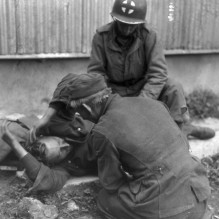- The Dream About Evidence
- The DSM in Five Versions
- Critique of the DSM
- Humans Are Split Specimens
- Soldiers with PTSD
- What Now?
This is blog entry five of a series of six. You can access the other entries by clicking their titles above.
When the new PTSD law was passed in Denmark in 2013, professionals argued that the treatment of the soldiers most severely hit by the disorder was insufficient. A project to clarify the situation was implemented. Researchers would scan the brains of the soldiers as they returned home from their combat rotations. When news of the project reached the Danish Army’s Association of Constables and Corporals, the reaction was enthusiastic. “If studies can document that the brains of soldiers suffering from PTSD function differently from those of healthy individuals, it will hopefully lead to a broader acceptance of the disorder by the population.”
In the preceding paragraph, a number of agenda interweave: research, treatment, economy, politics, and, last but not least, the soldiers’ longing for recognition of the dangers warfare exposes them to, including the risk of developing PTSD. The patchwork of agenda notwithstanding, science is in this case the sole explicitly shared reference for both professionals and soldiers. More specifically, the hope is that brain scans will give useful, new, scientific insight into the pathology of the disorder. Soldiers and researchers are not alone in this hope. The hope comports well with the present, widespread fascination with the brain. It is therefore not unreasonable to imagine, as the soldiers do, that if recognition is to come from somewhere today, the brain is a good bet. Whether scans of the organ can fully live up to expectations is quite another matter, however.
Aside from adding to the amount of radiation subjects are exposed to, scans are not per se the problem. They may well furnish new information on the neurophysiological mechanisms by way of which PTSD symptoms express themselves. Even so, the problem—i.e., the tendency to understand a syndrome like PTSD in scientific and technological terms alone—will remain. Expectations of further breakthroughs in the near future—as the expression often goes, not only in the mass media but in the scientific literature as well—will perhaps even exacerbate the problem. The point is that with its interwoven agenda, the PTSD diagnosis is not amenable to an antibiotics type solution, however much psychiatry would like to emulate somatic medicine (remember blog entry one of this series). In other words, brain scans can only partially cover the constructed politico-scientific definition of PTSD. For one, the PTSD diagnosis exceeds science. For two, science itself is not immune to the extra-scientific motives of human subjects who in this case partook in shaping the PTSD diagnosis. Yet the brain is expected to give answers to questions that more have to do with relations and the mind than with the organ.
Soldiers and their therapists know full well that factors other than the brain influence how they manage their missions. For example, the relationship between soldiers and their officers play a significant role. These are relational matters, not simply questions of brain physiology, even if human relations are in part mediated by neurophysiology. Still, the dream of explaining relational factors with measureable brain activity has never seen better days. Hence, a widespread discourse that tends to blur the distinction between brain and mind, letting the brain stand for both. The discourse feeds practices where science and technology serve to evaluate, certify, regulate, and administer all sorts of tasks based on the unarticulated assumption that it is possible to increase effectivity by neutralizing or even altogether ignoring the human factor. Granted, in some strictly technical contexts, the approach has its merits. In contexts involving subjects, it is nonsense. Increased efficiency of a process may sometimes be possible, never increased effectivity, to the extent that effectivity implies an actual effect on subjects. The effectivity of tasks designed to benefit the minds of human subjects will invariably fall short if based on their exclusion.
The PTSD diagnosis exemplifies ways in which the DSM encourages the use of a language that leaves little room for subjects. This is true for both patients and therapists. Another way in which the DSM does so is by transforming increasing parts of normality into a psychopathological diagnosis. Hence the DSM’s contribution to the dehumanization of psychiatric practice. Definitions and directives may seem down to earth and easy to grasp, but they are a poor mirror of our reality and not on a par with the problems we face. The recognition of soldiers is not primarily a matter of brain but a matter of mind.
Next: What Now? You can access the next and final blog entry in this series by clicking here.
2014-12-01


